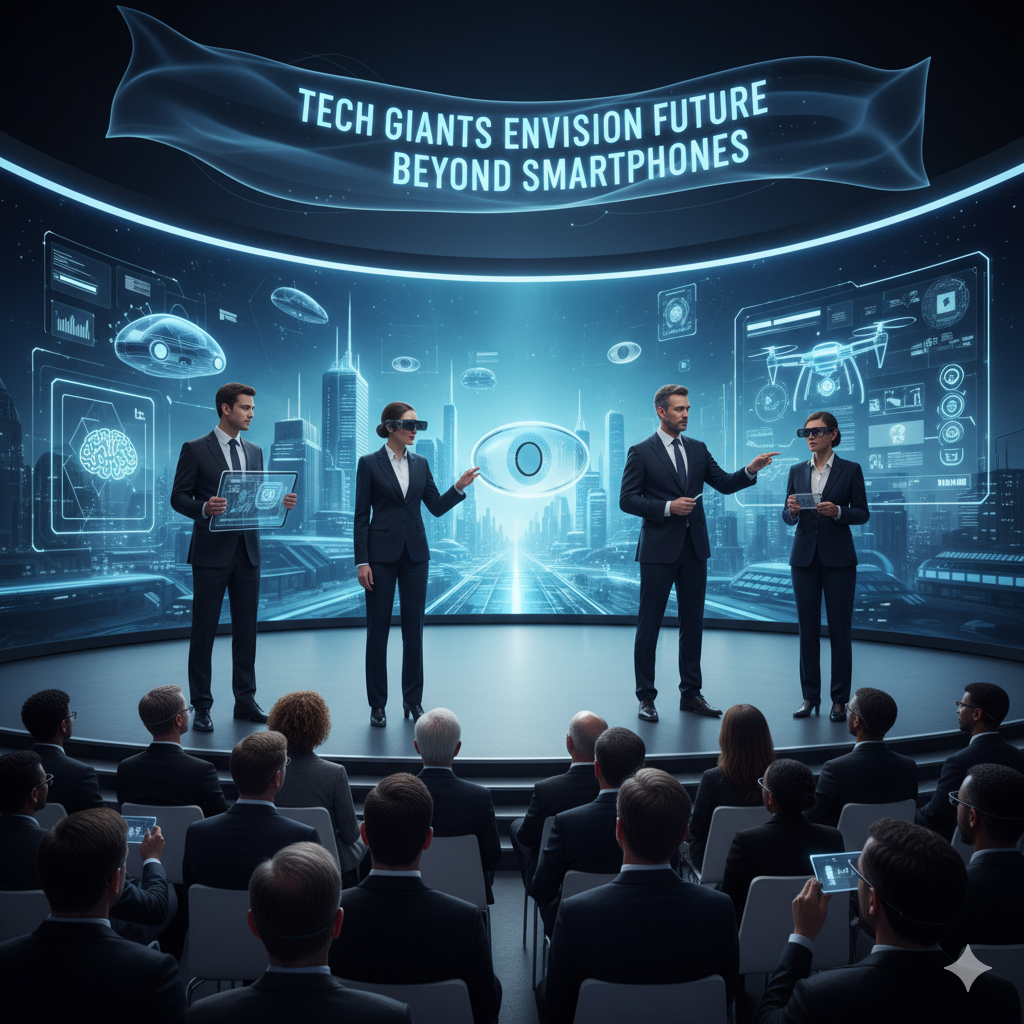Introduction Tech Giants Envision Future Beyond Smartphones
For over a decade, smartphones have been our windows to the digital world — connecting, entertaining, and empowering billions. But even the most revolutionary tech eventually hits a wall. As innovation slows and devices become more alike, tech giants like Apple, Google, Meta, and Microsoft are turning their eyes toward the next frontier — a world beyond smartphones.

The Saturation of the Smartphone Market
The smartphone market has matured. Once marked by rapid leaps — from touchscreens to 5G — it’s now plateauing. Consumers upgrade less frequently, and hardware innovation feels incremental. This slowdown has prompted major players to ask: What comes after smartphones?
What’s Next After Smartphones?
The next big wave isn’t just a new device — it’s a paradigm shift. Tech leaders are betting on immersive technologies like augmented reality (AR), artificial intelligence (AI), and spatial computing to redefine human-computer interaction.
Apple’s Vision: The Era of Spatial Computing
Apple has long been the trendsetter in consumer tech, and with the Apple Vision Pro, it’s paving the way toward spatial computing. This new dimension blends digital and physical realities, allowing users to interact with apps, media, and environments using eyes, hands, and voice — no screen required.
Apple’s strategy hints at a future where the iPhone’s successor isn’t another handheld — it’s a wearable that brings computing into your surroundings.
Google’s Bet on Ambient Computing
Google envisions a world where technology becomes invisible yet ever-present — a concept known as ambient computing. Devices like Nest, Pixel, and Android Auto are early pieces of this puzzle.
The goal? Seamless integration where your digital assistant anticipates your needs without a single tap — “Hey Google” becomes the bridge to a world where context replaces screens.
Microsoft’s Role in the Post-Smartphone Era
Microsoft is positioning itself differently — focusing on AI copilots and cloud-powered productivity. Through tools like Microsoft 365 Copilot and HoloLens, the company is building a hybrid world that merges reality, AI, and virtual collaboration.
Instead of another gadget, Microsoft aims to create AI-augmented workspaces — accessible across devices, no smartphone dependency required.
Meta’s Push Toward the Metaverse
Meta (formerly Facebook) has gone all in on the metaverse, envisioning a universe where digital experiences merge seamlessly with physical ones.
Their Quest VR headsets and smart glasses aim to replace traditional displays with immersive, 3D experiences — letting people work, socialize, and explore without staring at a phone screen.
Samsung’s Strategy: Flexibility and Beyond Displays
Samsung, the hardware giant, continues to innovate with foldable and rollable phones, but even it knows this is just the beginning. The company’s research into wearable displays, smart rings, and integrated ecosystems reflects a clear vision: the next evolution of mobile isn’t a device — it’s an ecosystem that adapts to you.
The Role of Artificial Intelligence
AI is the heartbeat of the post-smartphone future. It’s moving from reactive to proactive — understanding context, predicting behavior, and acting autonomously.
Imagine a system that reminds you to hydrate, books meetings based on your availability, or controls your smart home without command. That’s the AI-powered world tech giants are racing to perfect.
Wearable Technology and Smart Ecosystems
From smartwatches and glasses to neural implants, wearable tech is shrinking the gap between humans and machines.
We’re heading toward “always-on” ecosystems, where your wearable devices sync seamlessly — transferring data, preferences, and insights across every part of your life.
Human-Computer Interaction Revolution
The future of interaction is hands-free and screenless. Voice, gesture, and brain-signal recognition are becoming the new modes of input.
No more swiping — imagine thinking a command and having it executed instantly. That’s not sci-fi anymore; it’s the direction neurotechnology is taking.
The Future of Work and Communication
The pandemic accelerated digital transformation, but smartphones were just the start. The next step is AI-assisted, AR-powered workspaces where collaboration happens in virtual rooms — not through tiny screens.
Meetings will happen in 3D holographic spaces, and your “office” will travel with you anywhere.
Challenges in the Post-Smartphone Era
This transformation isn’t without challenges.
- Privacy: More sensors mean more data — and higher risks.
- Accessibility: Cutting-edge tech must remain affordable.
- Ethics: Balancing automation with human control is crucial.
The question isn’t just can we move beyond smartphones, but should we — and at what cost?
What It Means for Consumers
For users, the shift means redefining what “connected” means.
You won’t need to pull out a device — your environment becomes the interface. It’s exciting but also unsettling. Are we ready to live in a world where technology is everywhere yet nowhere visible?
Conclusion
The smartphone isn’t dying — it’s evolving into something bigger.
The next decade won’t be about holding technology in your hand but living within it. Tech giants aren’t just imagining a future beyond smartphones — they’re already building it, one immersive experience at a time.
FAQs
- What will replace smartphones in the future?
Smart glasses, AR/VR headsets, and AI-driven wearable devices are expected to take over the role of smartphones. - How will AI change the way we interact with technology?
AI will shift us from manual input to contextual automation — devices will predict and act on our needs proactively. - What is Apple’s Vision Pro, and why is it important?
Apple Vision Pro is a mixed-reality headset that introduces spatial computing, blending digital experiences with real-world interactions. - Are foldable phones the future or a temporary phase?
Foldables are likely a transitional phase, paving the way for screenless, wearable, and spatial devices. - How will privacy be managed in the post-smartphone world?
Companies will need stricter data governance, transparency, and advanced encryption to protect users as technology becomes more immersive.


